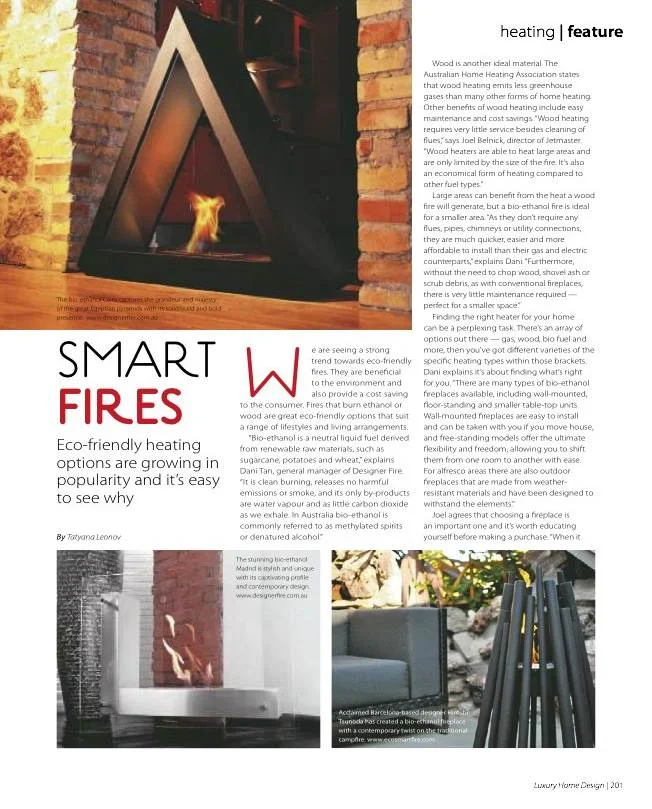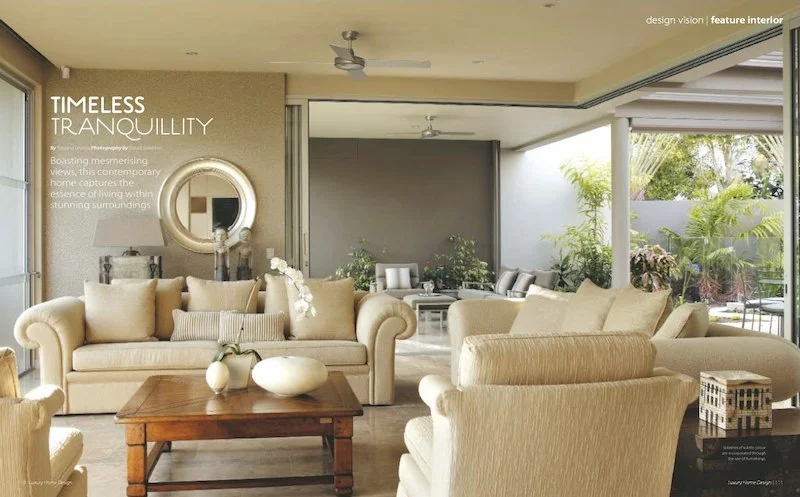Smart Fires
Eco-friendly heating options are growing in popularity and it’s easy to see why
We are seeing a strong trend towards eco-friendly fires. They are beneficial to the environment and also provide a cost saving fires to the consumer. Fires that burn ethanol or wood are great eco-friendly options that suit a range of lifestyles and living arrangements.
“Bio-ethanol is a neutral liquid fuel derived from renewable raw materials, such as sugarcane, potatoes and wheat,” explains Dani Tan, general manager of Designer Fire. “It is clean burning, releases no harmful emissions or smoke, and its only by-products are water vapour and as little carbon dioxide as we exhale. In Australia bio-ethanol is commonly referred to as methylated spirits or denatured alcohol.”
Wood is another ideal material. The Australian Home Heating Association states that wood heating emits less greenhouse gases than many other forms of home heating. Other benefits of wood heating include easy maintenance and cost savings. “Wood heating requires very little service besides cleaning of flues,” says Joel Belnick, director of Jetmaster. “Wood heaters are able to heat large areas and are only limited by the size of the fire. It’s also an economical form of heating compared to other fuel types.”
Large areas can benefit from the heat a wood fire will generate, but a bio-ethanol fire is ideal for a smaller area. “As they don’t require any flues, pipes, chimneys or utility connections, they are much quicker, easier and more affordable to install than their gas and electric counterparts,” explains Dani. “Furthermore, without the need to chop wood, shovel ash or scrub debris, as with conventional fireplaces, there is very little maintenance required — perfect for a smaller space.”
Finding the right heater for your home can be a perplexing task. There’s an array of options out there — gas, wood, bio fuel and more, then you’ve got different varieties of the specific heating types within those brackets. Dani explains it’s about finding what’s right for you. “There are many types of bio-ethanol fireplaces available, including wall-mounted, floor-standing and smaller table-top units. Wall-mounted fireplaces are easy to install and can be taken with you if you move house, and free-standing models offer the ultimate flexibility and freedom, allowing you to shift them from one room to another with ease. For alfresco areas there are also outdoor fireplaces that are made from weather- resistant materials and have been designed to withstand the elements.”
Joel agrees that choosing a fireplace is an important one and it’s worth educating yourself before making a purchase. “When it comes to wood heaters, slow-combustion freestanding fireplaces (generally steel or cast-iron fireboxes with a front glass door) are generally better at providing heat as they are completely exposed in the room,” he says. “Open-fireplace convection heaters can also be built freestanding and these provide a radiant heat which ensures the room is heated well.”
Hydronic heating
Did you know that hydronic heating dates back as far as Roman times? This efficient, safe and comfortable heating method has been used by people for hundreds of years because it works. Here we chat to Nigel Hunt, managing director of H20 Heating, who has more than 20 years of experience in both designing and installing hydronic heating systems
What is hydronic heating?
Hydronic heating is a method of heating the home through the use of hot water as opposed to forced warm air. Simply explained, a central hydronic boiler heats the water that is then circulated throughout the home using a network of pipes. These pipes are connected to an outlet in each room; an outlet can be a radiator panel, in-floor trench convector, in- slab floor coil (under-floor heating) or a combination.
Hydronic heating has evolved into one of the most efficient, controllable and comfortable ways to heat the home. While hydronic heating systems use water to provide heat, the water within the system is constantly recycled and circulated through the system, with no demands on water usage.
Where can it be used?
With the numerous options available, hydronic heating can be used in new builds, renovations and in existing homes, although in these cases consideration must be given to how the pipe work will be installed, especially when a property has polished floorboards and plastered walls.
What kind of a system do you need?
There are essentially two types of hydronic heating systems: underfloor, where a series of floor coil circuits are laid in the concrete slab or secondary pour of the building; and panels where pipe work is run from a central boiler to each room. The two systems can also be combined.
What hydronic heating products are available?
Boilers, radiators, designer radiator panels, towel rails and trench heating are the most common options.
Boilers: In all hydronic heating systems there is a central boiler which provides the heat (there are also boilers available that will provide the hot water for a property but due to constraints on water usage, these are advisable only for smaller properties). The gas boilers available have minimum efficiency ratings of 80 to 95 per cent efficiency (taken from UK Sedbuk test results).
Radiators: A radiator panel system is the most popular form of hydronic heating system and there is a wide range of panel options available, from standard steel-panel radiators to cast-iron panels reminiscent of a bygone era to innovative designer panels more like a work of art than a heating appliance. Growing in popularity is the flat-panel radiator that has a smooth fascia to provide a contemporary look.
Towel rails: By far the most popular product is the inclusion of a towel rail into a hydronic heating system. Again, there is now a wide selection of towel rails to choose from, including the classic ladder style and those making more of a style statement. Here, function and form are truly combined.
Benefits of hydronic heating
1. It’s quiet. In fact, hydronic heating is a naturally silent radiated heat (no noisy fans or squeaky heaters with constant blowing air).
2. It’s a healthier option. Hydronic heating has long been recognised for its benefits over a ducted-forced draft system because it doesn’t force air around the home, thereby eliminating the dust, humidity and dryness that can come with a fan-forced heating system.
3. Hydronic heating is versatile. It suits all types of properties and can be fitted to existing and new homes. If you feel you need more heating (or less), hydronic heating is a flexible option because adding radiators and convectors is quite simple, providing there is adequate boiler capacity.
4. Hydronic heating allows for individual rooms or zones to be heated independently so running costs are lowered and this provides the ability to control the heat requirements of each individual room to suit your family’s needs.
5. Water is used to provide heat in hydronic heating systems and the water is constantly recycled and circulated through the system. This means that apart from requiring a small amount of water to top up the system at yearly services, the demands on water usage are very low.
6. Today’s hydronic heating outlet options come in a diverse selection of styles, ranging from cast-iron panels to innovative cutting-edge designer panels. Alternatively, you can choose to have the panels with floor trench convectors or an in-slab floor coil system — select the look that will suit your home.
7. Maintenance levels can be low. If you choose a system with high-quality manufacturing and a long-term warranty, you can be confident your system will provide reliable heat for many years.
8. Today’s systems are full of technological features that not only increase their efficiency, but make them reliable, safe and cost- effective to run.





